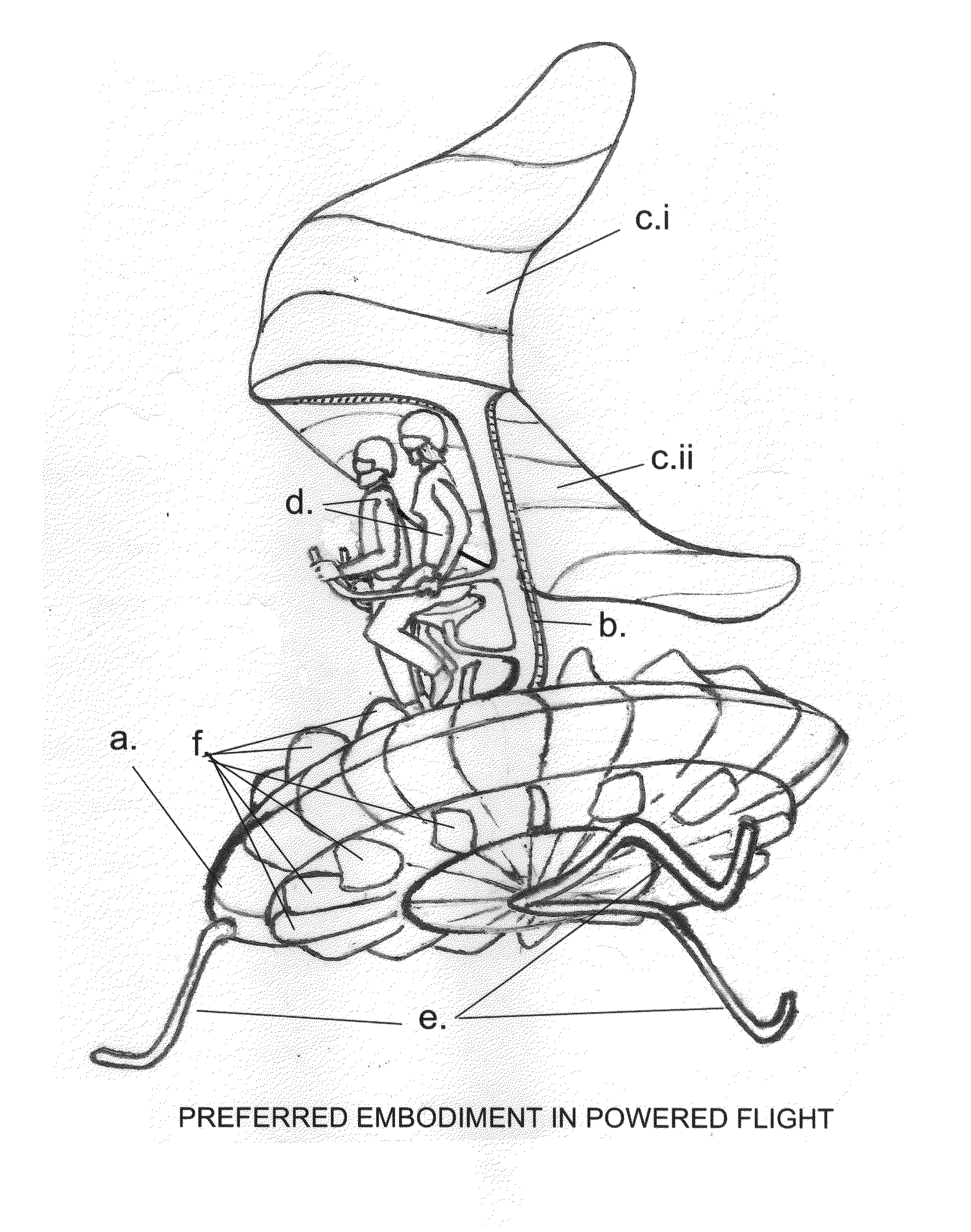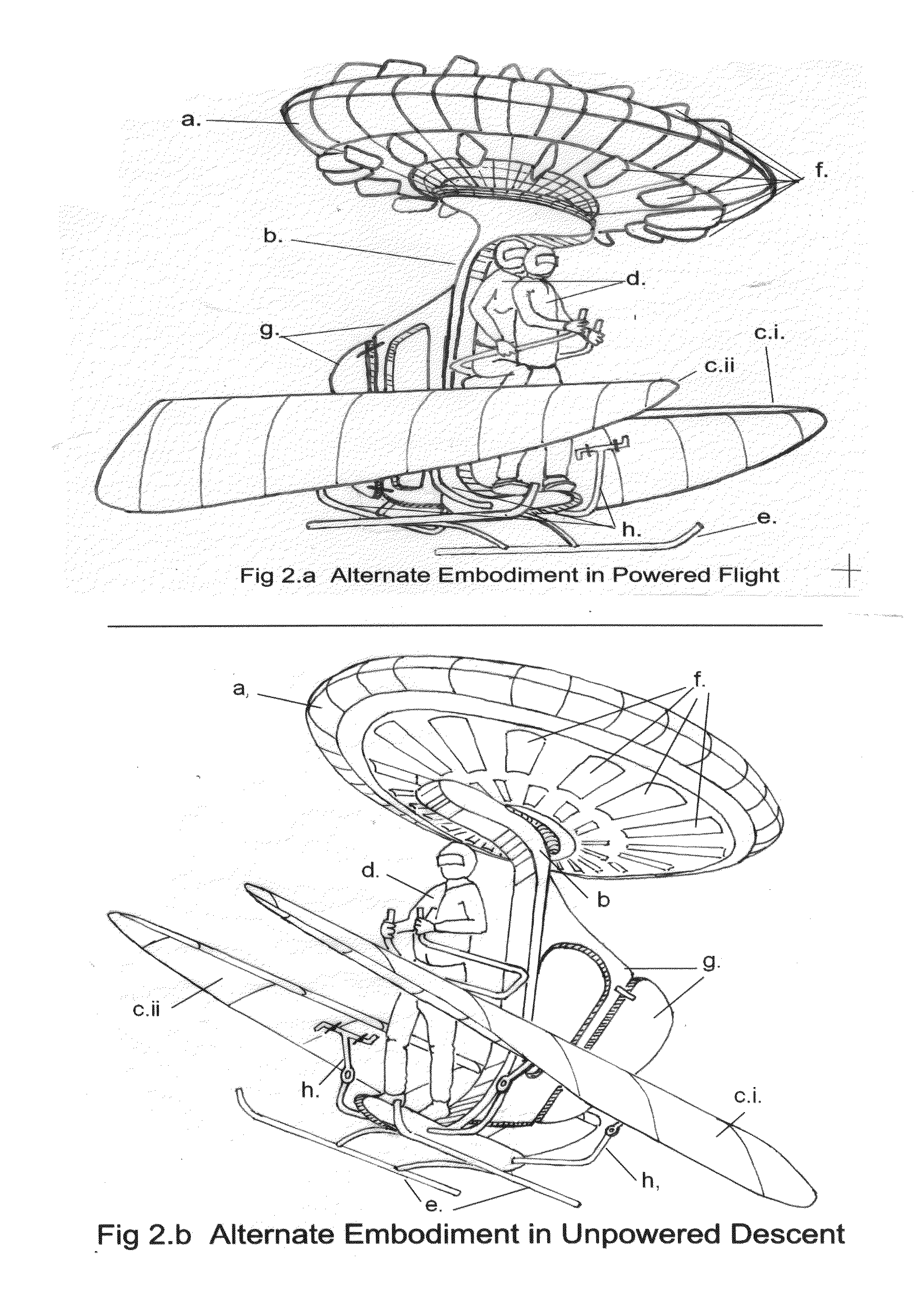Prior art flying platforms and small helicopters have sought to provide a VToL Personal Flying Vehicle as a practical recreational vehicle, but have not sufficiently satisfied issues of safety—especially regarding engine failure and un-powered descents, and over-complexity of the
control system, which render the prior art air vehicles unsuitable for
recreational use.
These measures have been deemed insufficient by the public because to date, no vertically-flying personal aircraft have gained wide acceptance in the recreational marketplace.
But flying platforms have a major stability problem; being top-heavy, they are ‘tippy’ and can over-rotate to an inverted position when tilted too far.
However, problems include the possibility of the vehicle being at too low an altitude for adequate time for the parachute
canopy to inflate.
The
pilot may be incapacitated or momentarily frozen by the stress of the moment.
These parachutes provide no control over the descent, which may land the vehicle dangerously, in a body of water, busy highway, etc.
Since rotors aren't efficient at developing lift than are
fixed wing aircraft, flying platforms are less fuel-efficient, with less range.
To date, no ultra light VToL air vehicle designs have attempted to modify the aero-form itself, to serve as a secondary means of descent in the event of propulsion-
system failure.
Personal helicopters are a growing market, but require a substantial commitment in cost and
training time required, and will never, for these reasons, become the ‘popular backyard flyer’.
A wide-
diameter open rotor, mechanical and operational over-complexity, and no substantial means of secondary descent in the event of failure of the primary rotor to auto-rotate, all conspire to make the conventional helicopter a poor candidate as a
mass-market VToL flier.
Rotor tip-strikes against obstacles near the ground is the most common causes of helicopter accidents.
They have limited lift, and are too expensive for the average person.
Since rotors aren't as efficient at producing lift than a fixed-wing, helicopters are less fuel efficient, with less utility and cross-country capability.
Thus, while it is not capable of a vertical take-off, Rogallos can be made to descend vertically, or nearly vertically, with very little forward motion.
In summary, the para-
glider is not capable of vertical take-offs, like a helicopter.
As noted, although the nominal
wingspan of this type, at around 9 meters, is suitable for vertically taking-off from a
confined space if it were so able, its inability to lift vertically and the need for a large area for take-offs is a big drawback.
Like other deflected-thrust types, the ArcWing suffers the major
disadvantage of loss of thrust during the re-directing process, requiring more powerful, heavier motors for vertical take-offs.
Therefore the glide characteristics are poor, with a relatively high stall-speed, low glide ratio, and fast rates of descent.
In the event of an engine failure of a conventional helicopter type, a gliding-type landing is attempted by the
pilot by a process of autorotation, but this requires much training.
Damage to a rotor is a more serious problem, because there is no opportunity for any secondary descent capability, such as a ballistic parachute.
Because of the complexity of their
control system and the high training requirement, helicopters of a conventional configuration are unlikely to become widely popular as a recreational flyer.
Unfortunately, it was difficult to engineer a co-axial, counter-rotating rotor
system that is also capable of auto-rotating and, being generally of the ducted variety, these rotors are of too small a
diameter to effectively auto-rotate in any case.
Its not an
ideal solution, because of the potential for
mechanical failure of the ejection
system, and because it may require the fast reaction of the pilot to an emergency situation and is not automatic.
The motorized paragliders' biggest drawback is that it is not capable of Vertical Take-offs and Landings (VToL) but only SToL (Short Take-off and Landing).
VToL vehicles of this type, having the lifting rotor buried within the fuselage, tend to be bulky, with a poor aspect-ratio, and the generally stubby wings appended to the fuselage produce poor gliding characteristics, with relatively high stall speeds.
There is no
advantage to large multi-passenger helicopters or gyroplanes being formed into, or adopting the shape of a parachute-
glider, because any wing or
appendage of reasonable proportion will be too small in area, in relation to the vehicle's weight, to produce a slow vertical descent.
From this perspective, the addition of a horizontal rotor for VToL flight might seem a logical next-step in the art, but the reality is that the marriage of a descent system based on a parachute-like element, together with a lifting system comprising a rotor, with the attendant problem of its downwash, is anti-intuitive.
However, there is a limited set of configurations that can successfully mate the two elements.
 Login to View More
Login to View More  Login to View More
Login to View More 


